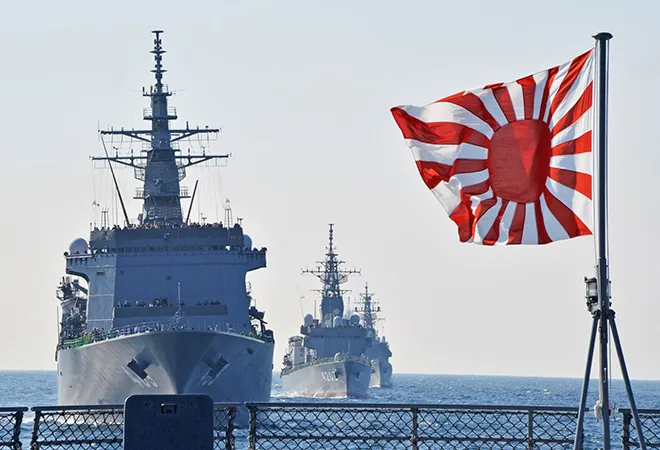-
CENTRES
Progammes & Centres
Location
Tokyo has acknowledged that a Chinese invasion of Taiwan would be “an emergency situation” for Japan and has stepped up engagement accordingly.

In 2021, a samurai on horseback, grim and forbidding in full battle armour, graced the cover of Japan’s Defence White Paper. The samurai was replaced this year by an eclectic, almost abstractionist collection of art on a field of blue. It is odd that a comment on Japan’s newest strategic document should begin with a note on aesthetics. Yet, the choice of a martial samurai was at the centre of controversy in 2021 after some took it to be representative of Japan’s return to ‘militarism’. One is free to make what one will of Tokyo’s choice of a less descriptive and safer cover for this year’s Defence White Paper. Irrespective of what their views on cover designs and colour schemes may be, Tokyo’s defence planners have laid out a sweeping view of Japan’s security challenges. A cursory examination reveals what keeps Japanese policymakers up at night: Beijing’s drive towards military modernisation. China’s much vaunted “Civil-Military Fusion” programme, which aims to integrate the Asian giant’s civilian production and innovation base with military priorities, remains a particular focus for Japan. Beijing’s ambition to wage “intelligised” wars, by integrating advanced technologies like Artificial Intelligence, on its path to becoming a “world-class military”, remains of deep concern.
China’s much vaunted “Civil-Military Fusion” programme, which aims to integrate the Asian giant’s civilian production and innovation base with military priorities, remains a particular focus for Japan.
Tokyo has also watched Russia’s invasion of Ukraine with increasing disquiet. Reflecting Prime Minister Kishida’s conviction that “Ukraine today may be East Asia tomorrow”, the defence white paper outlines a widespread fear that violations of territorial sovereignty and the international status quo may become a depressingly common affair in years to come. North Korea rounds off this unholy trinity of geopolitical threats for Japan. Its seemingly unending missile tests in 2022 send a clear message that Pyongyang’s considerable nuclear arsenal is undergoing considerable modernisation.
Tokyo’s strategy is threefold: Strengthen deterrence by expanding Japan’s defence capabilities; bolster the United States (US)–Japan alliance; and push for greater cooperation with other nations in the Indo-Pacific. Each deserves equal attention.
To begin with, Prime Minister Kishida’s party has finally thrown its weight behind an expansion in defence spending. Japan’s cabinet endorsed a doubling in defence spending over five years, a move that will make it the third largest defence spender in the world after the US and China. Tokyo’s national security elite, ensconced in Kasumigaseki and the Kantei, has plans for this increased funding. First, the armed forces have shifted their strategic weight towards the Southwest by establishing a host of new military facilities on the country’s southern island chain. Their objectives are clear, as a glance at a map reveals that Taiwan and China are, nautically speaking, a stone’s throw away. Second, funding for the research and development of advanced military technologies is likely to increase. From electromagnetic-powered railguns to high-power microwave beams, Japan is turning to technology to serve a range of needs from ballistic missile defence to disrupting drone attacks. In addition, there is a drive to strengthen intelligence, surveillance and reconnaissance capabilities. Intelligence and analysis were long considered to be a chink in Tokyo’s national security apparatus. Shinzo Abe’s many legacies include leaving behind a more centralised and less stovepiped intelligence community.
The armed forces have shifted their strategic weight towards the Southwest by establishing a host of new military facilities on the country’s southern island chain.
Finally, Tokyo has watched with rapt attention as cyber and space become the next frontiers of modern warfare. It has stood up military units dedicated to enhancing its situational awareness in space and preparing it for the challenges thrown up by electronic warfare. For a country that has routinely underinvested in its cyber defence preparedness, such changes can only be for the good. Concerns abound though as much of Japan’s success will depend on its ability to integrate its civilian technological base with its security aspirations. Given the traditional reluctance of the Japanese scientific community to participate in research with military applications, Tokyo will have its hands full.
Another principal focus is the US–Japan alliance. From sanctions on Moscow to coordination over military action in the Taiwan Strait, Washington and Tokyo have drawn ever closer. Even as the international order faces repeated challenges, both sides seem determined to make the alliance a key pillar of regional stability. While cooperation on the China challenge is an obvious focus for the alliance, ironing out economic security strategies and deepening technology cooperation will be frontiers for the future.
Finally, Japan’s defence strategy places a premium on its partners in the Indo-Pacific. The Ministry of Defence hopes to secure a Free and Open Indo-Pacific, in concert with its partners, by encouraging “cooperation and exchange of personnel, cooperation and exchange of troops, capacity building cooperation, and defence equipment and technology cooperation”. Japan’s drive to sign Reciprocal Access Agreements with Australia and the United Kingdom signal an increasing desire to deepen defence cooperation with interested powers, as the regional security order begins to deteriorate.
As Chinese missiles landed in Japan’s Exclusive Economic Zone, Japan scrambled its fighter jets and linked with America and Australia to condemn China’s ballistic missile launch.
The currently available digest version chooses not to mention the debate around the acquisition of offensive strike capabilities. In the past, Tokyo has been content to leave offensive operations to American forces. However, no less than the LDP National Security Research Committee, part of the ruling Liberal Democratic Party, has voiced its support for this course of action. While a modernising China and a recalcitrant North Korea have forced a serious rethink in Tokyo, offensive capabilities will change the nature of the US-Japan security alliance. Often called the “Sword and Shield”—which refers to America’s offensive capacities and Japan’s defence contributions—the US–Japan alliance will have to undergo a rethink of its traditional division of labour. The costs of acquiring offensive strike weapons, complete with the infrastructure that makes them so devastatingly effective, will also be considerable.
Japan’s new and more expansive version of its security interests was clear to see during the recent standoff over Speaker Nancy Pelosi’s visit to Taiwan. As Chinese missiles landed in Japan’s Exclusive Economic Zone, Japan scrambled its fighter jets and linked with America and Australia to condemn China’s ballistic missile launch. After maintaining a studied silence over Taiwan for more than half a century, Tokyo has acknowledged that a Chinese invasion of Taiwan would be “an emergency situation” for Japan and has stepped up engagement accordingly.
With Tokyo set to rewrite its National Security Strategy for the first time in nine years and one-time pipe dreams, like the acquisition of offensive strike capabilities, looking more likely, the transformation of Japan’s defence strategy is well and truly underway.
The views expressed above belong to the author(s). ORF research and analyses now available on Telegram! Click here to access our curated content — blogs, longforms and interviews.

Shashank Mattoo was a Junior Fellow with the ORFs Strategic Studies Program. His research focuses on North-East Asian security and foreign policy.
Read More +